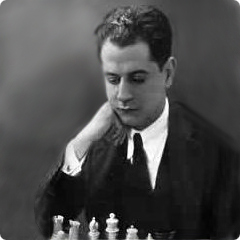José Raúl Capablanca (19 November 1888 - 8 March 1942)

Capablanca is widely considered to be one of the greatest players in the history of the game. He was born in Havana, Cuba, in 1888. He learnt the game at the age of four by watching his father play. His play developed rapidly, as is shown by his winning a match against Juan Corzo, the Havana Chess Club champion, by 7-5 at the tender age of twleve.
He then went to study in the USA at the University of Columbia. In 1909, he
beat Frank Marshall +8 -1 =14. After this victory, he was invited to play in
San Sebastian 1911, where he surprised his opponents by claiming first prize. Two of his opponents, Bernstein and Nimsowitsch had objected to Capablanca's participation since he had not yet won any international tournaments. They were both defeated by Capablanca though!
In 1913, Capablanca was employed in the Cuban Foreign Office as a commercial attaché. Thus, he was given the opportunity of travelling abroad in tournaments all over the world.
In 1914, he placed second behind the then World Champion, Emanuel Lasker, at
St. Petersburg. Before this, he had victoriously played in exhibition matches against many masters. This included a match against the young Alekhine. At the end of the First World War, Capablanca won at
Hastings 1919 and that same year he
defeated Boris Kostic by the neat score of 5-0. He won the
World Championship in 1921 by defeating Emanuel Lasker at Havana +4 -0 =10.
Capablanca was by then approaching the peak of his chess playing strength. He won first in
London 1922 and this was followed by second place in
New York 1924, behind Lasker, and third place in Moscow 1925, behind Boguljubow and Lasker. Then came his greatest success - first place at
New York 1927 ahead of, amongst others, Alekhine and Nimzowitsch.
Surprisingly he lost his World Title to Alekhine at Buenos Aires in 1927 by the score of +3 -6 =25. Although he participated in several events to prove his right for a return match, Capablanca was never granted one.
Capablanca had a string of other successful tournament achievements even in his later years. Though he performed badly at the
AVRO tournament in 1938, he scored +6 -0 =4 on Cuba's top board at the 1939 Buenos Aires Olympiad.
Capablanca died of a heart attack at the Manhattan Chess Club on 8th March 1942.
Though he did not write as many other prolific writers, he was noted for his excellent chess writings. He still has a great influence on the chess world and especially in the field of opening theory, most notably the Queen's Gambit and Nimzo-Indian.